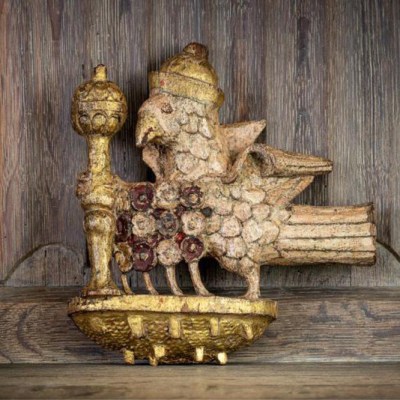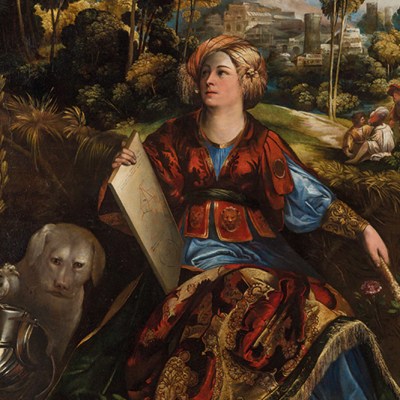From the March 2023 issue of Apollo. Preview and subscribe here.
For anyone mourning the closing of the Met’s recent blockbuster exhibition, ‘The Tudors: Art and Majesty in Renaissance England’ (or waiting impatiently for the National Portrait Gallery in London to reopen this June), another fix of the Tudors is at hand at Compton Verney in rural Warwickshire. The Met cast a wide net, presenting all manner of paintings, sculptures and examples of the decorative arts. By contrast, ‘Tudor Mystery: A Master Painter Revealed’ is tightly focused on a cluster of unsigned paintings associated with an enigmatic figure known, since the 1960s, as the Master of the Countess of Warwick: a moniker coined by Roy Strong, during his tenure as director of the National Portrait Gallery, on account of the fact that a portrait of Anne Russell, Countess of Warwick (c. 1569) at Woburn Abbey is particularly representative of the painter’s work.
In The English Icon (1969) – the first scholarly attempt to catalogue English easel paintings produced during the reigns of Elizabeth I and James I – Strong assembled a conjectural oeuvre of eight portraits associated with this painter (and indeed a copy of his seminal work is displayed in the exhibition, open to the page on which Anne Russell’s portrait is illustrated). In the intervening decades, subsequent generations of art historians have added considerably to Strong’s list. Today, about 50 paintings of courtly sitters – spanning the years from around 1561 to 1570 – are generally accepted as the work of the Master of the Countess of Warwick. The identity of this painter provides the ‘mystery’ of the exhibition’s title – and a means of talking about how art historians study Tudor paintings, as well as about the limits of what can and cannot be known about this period. It is a clever hook – and an excellent means of bringing the thrill of the academic chase to life for general audiences (and, indeed, for budding art historians).
Defining features of the painter’s hand include the presentation of the sitter’s head at a three-quarter angle; a certain softness-verging-on-fuzziness in the rendering of the hair; lips that meet in a straight horizontal line and blend into the surrounding flesh. Typically, the sitters are distinguished by their stiff deportment and upright posture. In addition, a particular attention to, and flair for, the rendering of clothing and jewellery is reminiscent of that seen in the paintings of Hans Eworth, a Flemish émigré active in London in the mid 16th century, who, unusually for a painter working in Tudor England, did sign his paintings. Strong noted the echoes of Eworth in The English Icon and it has often been suggested that Eworth may have trained the Master of the Countess of Warwick.
Thomas Knyvett of Ashwellthorpe (c. 1569), Master of the Countess of Warwick (Arnold Derickson?; active mid 16th century). Compton Verney, Warwickshire. Photo: Prudence Cumming Associates

The exhibition brings together eight paintings currently attributed to the Master of the Countess of Warwick. Compton Verney’s own Thomas Knyvett of Ashwellthorpe (c. 1569), which was not on Strong’s list, occupies pride of place. It is the first painting a visitor encounters and it was, according to the catalogue, the work that inspired curator Amy Orrock to mount this exhibition. Anne Russell, Countess of Warwick – Strong’s original ‘touchstone’ image – is here, too, newly cleaned and restored. The remaining six include two group portraits depicting families with young children in domestic settings: William Brooke, 10th Lord Cobham and his Family (1567; Longleat House) and Four Children Making Music (c. 1569; private collection) – a type of image which, though unusual in England at this time, was more commonly produced in the Netherlands. Extraordinarily, the musical notation in one of the open part-books in Four Children Making Music has been rendered accurately enough to be read (and has been identified as the bass part of a four-part motet by Josquin des Prez).
These paintings are juxtaposed with a handful of portraits by Eworth: as noted, an apparent influence on, and possible teacher of, the Master of the Countess of Warwick. The wall signage poses almost as many questions as it answers, highlighting what is known as well as what is not. Repeatedly, viewers are enjoined to actively engage with the paintings on display: to look, compare and form their own judgements.
This exhibition provides a reason to pay some much-needed attention to the 1560s: an overlooked decade in the study of Tudor art, sandwiched as it is between the death of Hans Holbein the Younger in 1543 and the emergence of Nicholas Hilliard, in 1571, as Elizabeth I’s portraitist of choice. It also lays bare the methods by which art historians, or at least those specialising in 16th-century English paintings, work. Rarely, if ever, is there a smoking gun. Rather, it is necessary to piece together clues from disparate sources, both visual and documentary. Absolute certainty is more often than not both elusive and illusive.
With all of this in mind, the exhibition explores a compelling theory, first proposed by Edward Town in an article in British Art Studies in 2020: that the painter Arnold Derickson – a Netherlandish émigré first recorded in England in 1549 as a servant (i.e. studio assistant) of Eworth – may have been the Master of the Countess of Warwick. Fragmentary manuscript sources pertaining to Derickson’s life in mid 16th-century London are discussed – many pertaining to his involvement, at least through the late 1560s, in the Dutch Church at Austin Friars, a nexus for émigré artists in London – and, in some cases, displayed or seen on videos playing in the gallery. As the wall signage notes, ‘Many questions remain, but the documentary fragments of Arnold Derickson’s life make him a good candidate for being the Master of the Countess of Warwick.’
The display concludes with two miniatures of 1569: one of Sir Thomas Knyvett from a private collection; the other, A Man in an Armillary Sphere from Waddesdon Manor. Both are tentatively attributed to the young Nicholas Hilliard, who, it is also posited, might have had some training in the 1560s from the Master of the Countess of Warwick. The jury is still out, as the catalogue freely acknowledges. But this thought-provoking exhibition no doubt will be a spur to further scholarly discussion and debate about Derickson, Hilliard and much else.
‘Tudor Mystery: A Master Painter Revealed’ is at Compton Verney in Warwickshire until 7 May.
From the March 2023 issue of Apollo. Preview and subscribe here.



